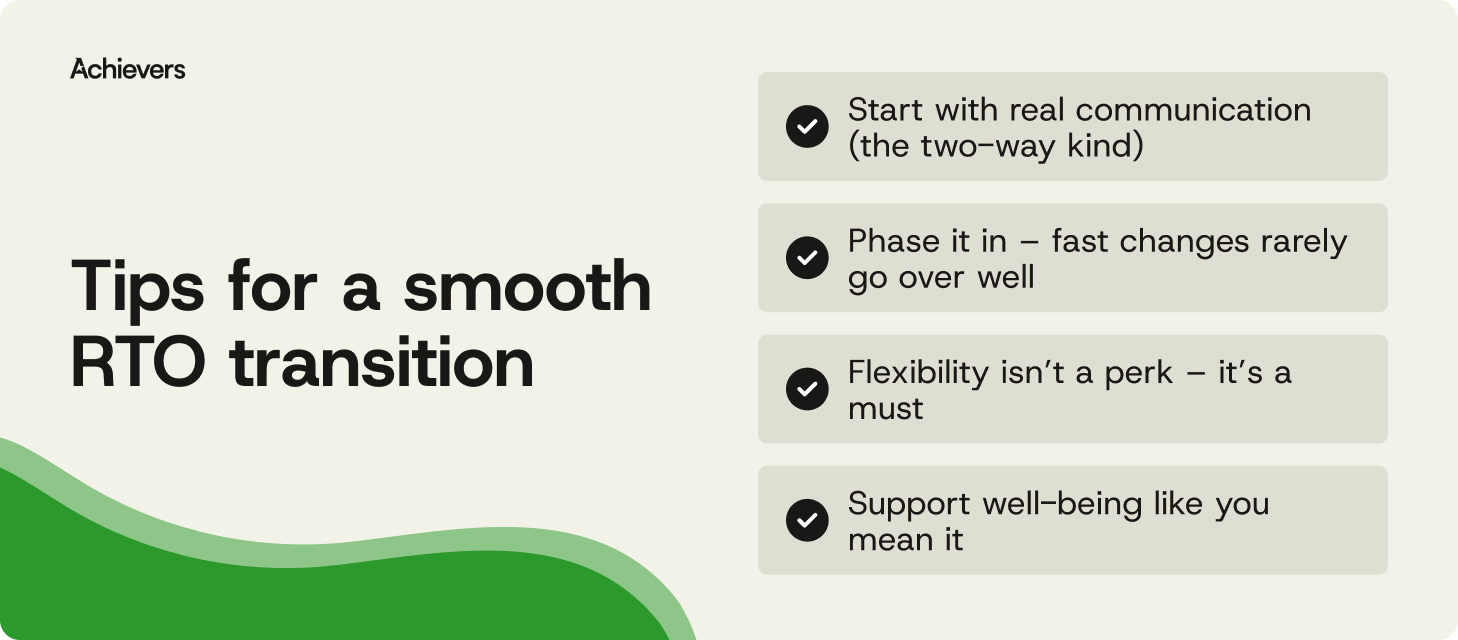Table of contents
Create a culture that means business™
Schedule a demo with an Achievers solution expert today.
Let’s be honest — the phrase “return to office” doesn’t exactly inspire a standing ovation. But like it or not, RTO mandates are here, and they’re reshaping how organizations approach culture, connection, and productivity. For HR leaders, that means finding the sweet spot between business needs and what employees actually want (spoiler: it’s not just a foosball table).
Done poorly, return to office efforts can backfire — cue disengagement, low morale, and top talent eyeing the exit. But done right? They can reignite a sense of purpose, reinforce culture, and bring teams closer together — whether they’re in-office, hybrid, or somewhere in between.
In this guide, we’ll walk through how to navigate RTO with empathy, strategy, and (yes) results. Because when people feel seen, heard, and appreciated — no matter where they work — they’re more likely to stick around and give their best.
Tips for a smoother return to office transition
Returning to the office isn’t just about desks and meeting rooms — it’s about people. And people don’t tend to respond well to rigid mandates wrapped in corporate jargon.
In fact, 80% of employers have seen attrition tied to inflexible RTO policies. But with a thoughtful, employee-first approach, this shift doesn’t have to feel like a step backward. Done right, it’s a chance to build trust, boost engagement, and create a more connected workplace.
Here’s how to make the return feel less like a command and more like a conversation:

Start with real communication (the two-way kind)
If you want employees on board, start by bringing them into the loop. Share the “why” behind the RTO policy — not just the logistics, but the intention. Communicate early and often through emails, all-hands, and team huddles. Then open the floor. Town halls, pulse surveys, and honest Q&As can help you uncover concerns before they turn into flight risks. When people feel heard, they’re far more likely to stay invested — and stay put.
Phase it in — fast changes rarely go over well
Going from fully remote to fully in-office overnight? That’s a culture shock. Instead, take a phased approach. Start with a couple of in-office days a week and build from there. Try pilot programs. Collect feedback. Adapt as you go. A gradual rollout gives employees time to adjust, leaders time to learn, and your RTO strategy time to breathe.
Flexibility isn’t a perk — it’s a must
Let’s not pretend flexibility is still up for debate. Hybrid models, flexible hours, and autonomy over how work gets done are now table stakes. Supporting flexible work arrangements isn’t just a nice gesture — it’s a smart retention move. Partner with managers to build structure and boundaries that support both business needs and employee well-being. A little flexibility can go a long way toward keeping teams motivated, present, and productive.
Support well-being like you mean it
Returning to the office can stir up more than just traffic complaints. Stress, anxiety, and burnout don’t disappear just because someone’s badge works at the turnstile again. Make sure employees have access to meaningful well-being support — from EAPs and counseling to wellness initiatives and manager training. Recognizing that people are human (shocking, we know) is one of the best things you can do for morale, culture, and retention.
The do’s and don’ts of return to office — HR edition
Let’s face it: getting employees back to the office is less about policies and more about people. HR leaders are walking a tightrope between business needs and human realities — and no, handing out branded water bottles won’t fix everything.
The good news? With the right approach, RTO can be less of a headache and more of an opportunity. Here’s your cheat sheet for what to do — and what to avoid — when navigating the return to office:
Do’s
- Listen before you lead: Before drafting a single policy doc, gather employee input. Surveys, one-on-ones, focus groups — whatever fits. The goal is simple: understand what your people want, need, and worry about. When employees feel involved, they’re more likely to buy in (and less likely to bail).
- Spotlight the upside: Don’t just say “back to the office” — show what’s in it for them. Think collaboration, in-person mentorship, career growth, and the kind of spontaneous brainstorming that just doesn’t happen over Zoom. Frame RTO as a step toward stronger connections, not just stricter schedules.
- Rebuild connection intentionally: Time apart changed workplace dynamics. Use that as your cue to invest in culture. Plan team-building activities, workshops, or collaborative projects that bring people back together — not just physically, but socially. A little camaraderie goes a long way.
Dont’s
- Default to a one-size-fits-all model: There’s no universal RTO plan that works for everyone. Forcing rigid policies can fuel disengagement and, eventually, exits. Embrace hybrid approaches that respect different roles, teams, and personal circumstances. Flexibility isn’t a compromise — it’s a strategy.
- Dismiss concerns: If someone’s hesitant about returning, that’s not rebellion — that’s human. Ignoring or minimizing feedback only breeds frustration. Instead, acknowledge concerns, communicate the “why,” and offer real support. It’s empathy that turns friction into trust.
- Micromanage: Back in the office doesn’t mean back to hovering. If the plan is to rebuild trust and connection, micromanagement isn’t going to help. Lead with empathy — understand that your team is still adjusting and give them space to thrive. Focus on outcomes, not attendance. Trust people to keep doing what they’ve always done: delivering results (now just with better coffee options).
Overcoming resistance to return to office
Let’s be honest — no one’s ever dreamed of commuting as their next big career move. So it’s no surprise that return-to-office mandates can stir up resistance. In fact, nearly half of remote workers say they’d consider quitting if required to return full-time. But with the right approach, what starts as pushback can become buy-in.
The key? Lead with empathy, stay flexible, and keep communication human. Here are a few ways to do just that:
Start by listening — and responding
Concerns about commuting, work-life balance, or lost flexibility aren’t just noise — they’re valid. Create space for honest dialogue through town halls, surveys, or manager check-ins. Then act. Whether it’s offering transit stipends, flexible hours, or a clear “why” behind the mandate, small accommodations can go a long way toward making employees feel heard, not herded.
Show, don’t just tell
Stats are nice. Stories are better. Share real-life wins from teammates who’ve found value in returning to the office — more collaboration, faster feedback, stronger connections. Case studies and testimonials help paint a picture of what’s possible beyond the commute and the cubicle.
Keep it flexible — one size fits no one
Rigid mandates rarely lead to lasting engagement. Instead, build in flexibility where you can. Hybrid models, phased schedules, or role-based exceptions show you trust your people and understand their realities. The goal isn’t to drag anyone back — it’s to bring them along, thoughtfully.
Future-proofing your workplace (yes, really)
Return to office isn’t just a logistics challenge — it’s a litmus test for how adaptable your workplace really is. But here’s the upside: it’s also a chance to design a more resilient, flexible organization that’s ready for whatever comes next. Change may be inevitable, but being unprepared? That’s optional.
Here’s how to build a workplace that holds strong through it all — from office shifts to industry shakeups:
- Flexibility first, always: Hybrid models, flexible hours, compressed workweeks — the more choice you offer, the more likely your people are to stay engaged (and stay, period). Flexibility is no longer a perk; it’s a foundational strategy.
- Reinforce culture like it matters — because it does: Company culture doesn’t live in the breakroom — it’s built through open communication, transparent leadership, and policies that put people first. Make it obvious that employee well-being isn’t a trend, it’s a priority.
- Invest in smart tech — not just shiny tech: Tools that actually help people work better? Yes, please. Think collaboration platforms, performance tools, and intelligent systems that support productivity no matter where teams are based.
- Plan for the curveballs: Global disruptions, economic surprises, the occasional once-in-a-century event — resilience means thinking ahead. Build contingency plans that help you pivot, not panic.
- Upskill like the future depends on it (because it does): Help employees stay sharp through training, reskilling, and development programs. When people grow, so does your business.
- Review. Rethink. Repeat: Workplace policies shouldn’t gather dust. Reassess regularly based on what employees need and how your business is evolving. The best strategies are the ones that aren’t set in stone.
Building a future-ready workplace isn’t about predicting what’s next — it’s about designing a culture and infrastructure that can flex with change. Start with empathy, invest in people, and maybe keep a backup plan or two (just in case).
Build a stronger, more connected workplace with Achievers
Rolling out a return to office plan isn’t just about logistics — it’s about people. And people don’t respond to mandates nearly as well as they respond to trust, transparency, and a little empathy. The organizations that lead with flexibility and prioritize employee well-being are the ones most likely to come out of this shift stronger, more engaged, and ready for what’s next.
As you guide your teams through change, remember: success starts with making employees feel seen, heard, and valued. Achievers can help you do exactly that — through recognition, connection, and engagement strategies built for moments just like this. Because the best workplaces aren’t the ones that resist change — they’re the ones that shape it.



